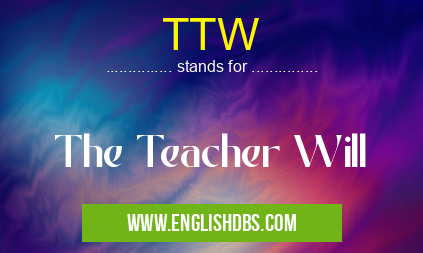What does TTW mean in EDUCATIONAL
TTW stands for The Teacher Will. It is an abbreviation commonly used in educational settings, particularly in online learning environments.

TTW meaning in Educational in Community
TTW mostly used in an acronym Educational in Category Community that means The Teacher Will
Shorthand: TTW,
Full Form: The Teacher Will
For more information of "The Teacher Will", see the section below.
» Community » Educational
Definition
TTW is a directive or instruction that indicates the specific actions or expectations of the teacher. It is used to guide students through learning activities, assignments, or assessments.
Types of TTW Statements
TTW statements can fall into various categories, including:
- Instructional: Providing clear directions on how to complete a task or assignment.
- Assessment: Informing students about the evaluation criteria or grading rubrics.
- Time Management: Setting deadlines or time limits for activities or assignments.
- Resource Management: Directing students to specific resources or learning materials.
- Interaction: Facilitating student collaboration or engagement through discussions, peer evaluations, or group projects.
Examples of TTW Statements
- TTW: Read chapters 1-3 and complete the online quiz by the end of the week.
- TTW: Your presentation should be 10-15 minutes long and include visual aids.
- TTW: The research paper will be graded based on the following criteria: clarity, organization, and evidence.
- TTW: Utilize the course discussion board to share your ideas and respond to your peers.
- TTW: Access the online textbook through the course website and complete the assigned readings.
Essential Questions and Answers on The Teacher Will in "COMMUNITY»EDUCATIONAL"
What does TTW stand for?
TTW stands for "The Teacher Will," which is a common phrase used in educational settings to indicate actions or responsibilities that the teacher will undertake.
What are the benefits of using TTW in the classroom?
Using TTW in the classroom can provide several benefits, including:
- Clarifying expectations and roles: TTW statements explicitly outline what the teacher will be doing in the lesson, reducing confusion and fostering a productive learning environment.
- Establishing a consistent structure: By using TTW, teachers can create a consistent routine, making it easier for students to follow and participate effectively.
- Promoting student independence: TTW statements help students understand that they have specific responsibilities and actions to take during the lesson, encouraging them to become more actively involved.
How can TTW be effectively used in lesson planning?
TTW statements should be incorporated into lesson plans in a clear and concise manner. Here are some tips for effective use:
- Use specific language: Use precise and unambiguous language to describe the teacher's actions.
- Be clear about expectations: Define the intended outcomes and what students should be doing in response to the TTW statement.
- Consider the learning objectives: Ensure that TTW statements align with the learning objectives of the lesson.
What are some examples of TTW statements?
Here are some examples of TTW statements that can be used in different educational contexts:
- "TTW present the key concepts of the lesson."
- "TTW provide students with opportunities to practice the new skills."
- "TTW guide students through the problem-solving process."
- "TTW facilitate discussions and encourage student participation."
Final Words: TTW is a concise and effective way to communicate teacher expectations in an online learning environment. It provides clear guidance to students, ensuring that they have a structured and focused learning experience.
TTW also stands for: |
|
| All stands for TTW |
